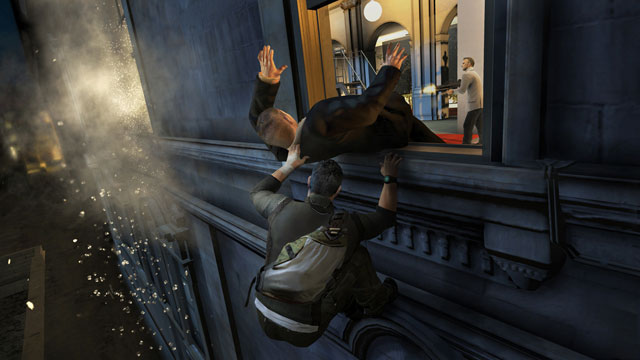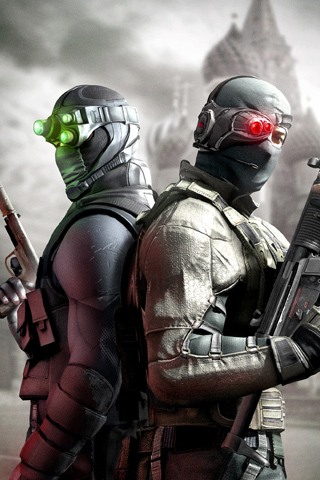This post has not been edited by the GamesBeat staff. Opinions by GamesBeat community writers do not necessarily reflect those of the staff.
He betrayed his friends, he lost his job, and now his daughter is presumed dead. Sam Fisher is an angry man. Some would think his rage is justified, but is it really?

Ubisoft thinks so, with their long awaited next installment of the Splinter Cell franchise. Their newest romp, Splinter Cell: Conviction, abandons, for the most part, the old silent-as-the-grave gameplay of it’s predecessors, instead playing more like a third person shooter with some basic stealth elements. Taking outlandish scenarios from shows like 24 or even the Bourne franchise, Conviction’s single-player narrative has Sam hunting down terror groups, unraveling government Coups, and finding those responsible for her daughter’s death. His unbridled rage is noticeable through the whole campaign, all the way up to the fairly satisfying conclusion.
The crucial light and sound gauges from previous Splinter Cell titles have now been replaced with an environmental cue, with the landscape changing to a black-and-white motif when Sam is unseen.
Enemy A.I. shows some sign of intelligence, checking corners and other hiding spots when suspicious, making some of Sam’s new toys all the more useful. As a decent way to maneuver out of a bad situation, Last Known Position shows, quite literally, your last known position to the enemy once you’re out of sight. This tactic also works well to lure enemies into traps or close enough for a hand-to-hand takedown. Sam’s new sonar goggles are a fair replacement of the original night-vision setup, including a new activation noise that sounds like you’re piloting a little submarine. And what use do these new goggles have? Why, to Mark and Execute, of course.
Adapted from another Tom Clancy branded title, Rainbow Six: Vegas, Sam’s new Mark and Execute ability may feel like a “win button” of sorts, and to a certain extent, it is. Depending on the weapon in your hands, you can mark a set number of targets, whether they are enemies or environmental hazards, using either your sonar goggles or old-fashioned line-of-sight. Now, with your targets marked and ready for execution, one would think to press the “win button” and headshot your way to victory. Wrong. Before you can hit your marks with stunning accuracy, you must first perform a close-quarters takedown, some of which are almost comically violent. Are these unmerciful acts really necessary?

Sam would think so, ditching his old, and more humane, takedowns for new and unexpectedly more brutal submissions. Is some random grunt standing in your way? Just shoot him in the head, or perhaps even, the kneecaps! Hanging off of a ledge above an unknown sap? Drop down on that helpless fool and snap his neck. While these displays could be appropriate given Sam Fisher’s unchecked anger through the single-player campaign, they feel a bit more out-of-place when playing the game’s co-op modes.
 Conviction’s co-operative element is the most akin to previous Splinter Cell games, requiring more stealth and patience than the action-oriented single-player portion. The game’s co-op campaign follows Archer, an American Third Echelon agent, and Kestrel, an agent of Voron, the Russian counterpart to Third Echelon. Archer and Kestrel have the same tools and abilities as Sam, and can used them in tandem to take down enemies with more strategy and tact.
Conviction’s co-operative element is the most akin to previous Splinter Cell games, requiring more stealth and patience than the action-oriented single-player portion. The game’s co-op campaign follows Archer, an American Third Echelon agent, and Kestrel, an agent of Voron, the Russian counterpart to Third Echelon. Archer and Kestrel have the same tools and abilities as Sam, and can used them in tandem to take down enemies with more strategy and tact.
The game’s Deniable Ops mode can also be played co-operatively, or you can lone wolf it for an even more traditional Splinter Cell experience. Hunter is similar to the co-op campaign, with you eliminating guards swiftly and silently to reach the next objective. The one downside is if you’re spotted, reinforcements are called in, seemingly from every angle. Last Stand has you defending an EMP generator, resembling something close to Gears of War’s Horde mode. Face-off is the game’s only real ‘multiplayer’ mode, pitting spy against spy with some hopeless guards thrown into the mix.
There’s not much more I can say about Splinter Cell: Conviction. The game diverts from the traditional stealth genre and attempts to play more like a third person shooter, more often in the single-player campaign than co-op. Last Known Position and Mark and Execute help to quicken the pace of combat, as well as the general lack of finesse during close combat. Conviction takes the franchise in a relatively new direction, and while lovers of the old style may look down on it’s more action-oriented feel, this title could be a stepping stone for any players either too tired or too hesitant toward the stealth genre.
